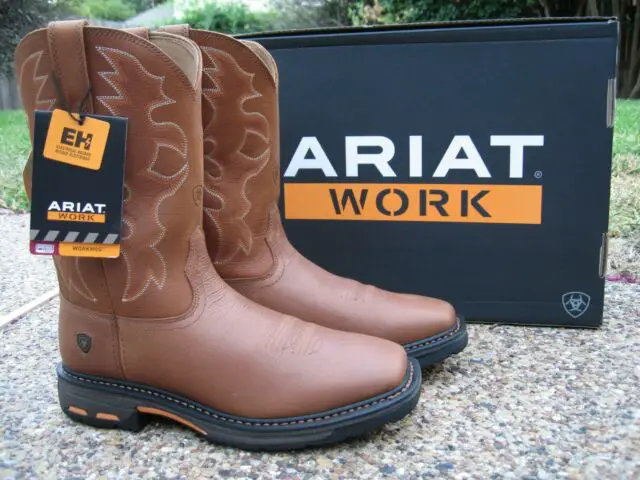Leather is one of the most durable materials and is naturally dirt resistant. Despite its ability to shine through years of use, it is prone to get dirty and dry.
When exposed to water, sun, or other harsh conditions, Leather boots will crack and need to be conditioned to make them look good and increase durability. To derive maximum usage from your boots, you must ensure that you clean and condition them regularly.
 Leather boots that are straight out of the factory contain a good amount of conditioners and have an intact layer of waterproofing on them. You must condition your leather boots right away if you notice that they were manufactured more than three months ago.
Leather boots that are straight out of the factory contain a good amount of conditioners and have an intact layer of waterproofing on them. You must condition your leather boots right away if you notice that they were manufactured more than three months ago.
When you get a pair of new leather boots…
First, clean them with a horse-hair brush to remove any dirt residue. Break them slowly; don’t put them to rough use right away after using them; clean and store them properly.
Leather absorbs moisture real quick, so where you store them is very important. For example, a cedar shoe tree is preferred by many, as it absorbs the moisture and keeps your leather boots safe.
Conditioning isn’t entirely necessary in the initial few months. A little bit of cleaning and polishing should be enough for your boots. It is difficult to say exactly when to start conditioning new leather boots as it depends on many factors like the type of leather, environment as such. But a good rule of thumb is to start conditioning them when they lose the shine and start to look dry.
Apart from that, there is not much care required in the initial months. You can spritz some water repellent if you are someone who works in wet conditions a lot. But otherwise, your new boots are good to go a solid 3-6 months with minimal cleaning.
What is a leather conditioner, and why should you use it?
Leather conditioner is specifically designed to restore damaged leather. It is easily absorbed by the leather and nourishes the fibers to restore their natural flexibility. Leather is porous in nature.
So it is easy for dirt and grime to get inside those pores. A conditioner helps by lubricating the fibers and thereby reducing the friction. It also forms a protective layer on the surface to prevent stains and deepens the color.
They usually come in three forms, conditioning creams, conditioning oils, and wax conditioners.
Conditioning creams nourish the leather from inside and cause little color change.
Conditioning oils are being used to make the leather soft again for a very long time. But make sure you use the right type of oil for your leather, as an inappropriate one can make it sticky.
Wax Conditioners will not go deep into the leather fibers, but they provide strong surface protection from water.
Differences between a leather cleaner and conditioner
The significant difference between a leather cleaner and a leather conditioner is that a cleaner is used to remove the accumulated dirt, grime, and grease over the surface. In contrast, a conditioner adds or replaces the natural oils that leather loses due to rigorous use.
When you get a pair of new boots, occasional cleaning with an appropriate cleaner should do. Dirt is not the greatest enemy of leather; dryness is. Harsh use of the boots regularly may result in the leather losing its natural oils and starts to crack up.
It is not advisable to use a home-made conditioner like milk or mink oil, as they might not be appropriate for the kind of leather your boots are made of.
You should apply a conditioner after cleaning the boots. It is essential to dry the boots completely before putting conditioner on them. You must ensure that the conditioner you are using is made of natural substances for an enhanced appearance.
See also: Mink Oil Vs Leather Conditioner: Which is Better?
When to apply the conditioner to your boots
As mentioned above, drying out is the worst enemy for leather articles. When exposed to water damage, the leather’s interweave will begin to weaken and forms visible cracks. There is no way to redeem it after it has happened. Prevention is the only way to stop this from happening.
Cleaning and conditioning of leather boots will increase the durability. The number of times you must condition your leather totally depends on your usage.
For regular use, you can condition your leather boots twice a year, but if you use them in harsh conditions, you must condition them at least three or four times.
When you find the appropriate conditioner for your boots, you must follow the instructions religiously to get the best results and not damage them.
How to apply the conditioner to your boots
Remove the laces and use a horse-hair brush to buff up the boots lightly. Then take a damp cloth, rub it over the cleaner to create lather.
Then gently clean the boots with the lather, especially over the areas that need extra scrubbing. Then let them rest for 10 minutes and wipe them off with a dry lint-free cloth.
Before you condition your boots, make sure they are dried completely. Put a small amount of conditioner onto a lint-free cloth (chamois or terrycloth works the best) and apply it to the boots in a circular motion.
Use as much product as the boots need and repeat the application two or three times if you haven’t treated them in a while. It is better to start with a little product and go again as required.
Never put the conditioner directly on your boots. You need to observe if the leather is starting to get dampened, which means you are about to stop putting any more conditioner on it.
You must then wipe off the excess product with a dry cloth and rest for at least 20 minutes. After they are rested for over 12 hours, rub them again with a dry cloth to ensure that you’ve removed all the extra oils and moisture.
Don’ts when using leather conditioners
-
-
- Don’t rub the conditioner too harshly on the boots. It might cause aberrations on the surface.
- Be careful when using home-made concoctions to clean or condition your leather. You need to know the right formula for your leather.
- Always do a patch test when using a cleaner/conditioner on a less visible area. They might have color-changing properties.
- Do not use extreme temperatures on your leather boots.
- Don’t force your boots to dry like using a hair dryer or radiator. Let your boots air dry even if it takes a longer time.
- Do not try to treat ink or other deep stains on your own; you might further damage the product. It is better to see an expert.
-
Can you use too much leather conditioner?
What a leather conditioner does is, it nourishes, conditions and softens the leather fibers by returning the nutrition and natural oils to the leather.
So, it is good to condition your leather from time to time whenever you feel that the leather is stiffening or losing in its natural luster and is getting cracks and creases.
But there is a limit to everything and excess of anything is bad. The same applies to leather conditioner as well.
Using too much leather conditioner will add extra moisture to the leather and can even rot the leather in times to come. When you use too much of leather conditioner, it will remain in the pores of the leather fibers which can emit smell from the leather.
Also, too much conditioner will make the leather boots softer than required, hence the uppers of the boots will lose its rigidity and will breakdown forming creases and can get separated from the soles.
Therefore, condition your boots not more than once a month and in case the leather is too dry, you can condition it twice a month and not more than that.
Typically a pair of leather boots will last in good condition for more than 3 years. When you buy a high-end product and use it with the right care, it might last indefinitely. Regular polishing and shining will increase your boots’ lifetime by 10 times.
Even though buying a good pair of leather boots seems like a lot of money, remember they might just be the most practical purchase you’ve made in a long time.







